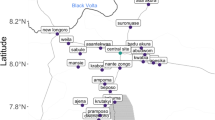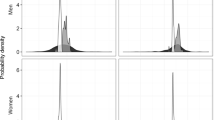Abstract
Using a case-crossover study design and conditional logistic regression, we compared the relative odds of transmural (full-wall) myocardial infarction (MI) calculated using exposure surrogates that account for human activity patterns and the indoor transport of ambient PM2.5 with those calculated using central-site PM2.5 concentrations to estimate exposure to PM2.5 of outdoor origin (exposure to ambient PM2.5). Because variability in human activity and indoor PM2.5 transport contributes exposure error in epidemiologic analyses when central-site concentrations are used as exposure surrogates, we refer to surrogates that account for this variability as “refined” surrogates. As an alternative analysis, we evaluated whether the relative odds of transmural MI associated with increases in ambient PM2.5 is modified by residential air exchange rate (AER), a variable that influences the fraction of ambient PM2.5 that penetrates and persists indoors. Use of refined exposure surrogates did not result in larger health effect estimates (ORs=1.10–1.11 with each interquartile range (IQR) increase), narrower confidence intervals, or better model fits compared with the analysis that used central-site PM2.5. We did observe evidence for heterogeneity in the relative odds of transmural MI with residential AER (effect-modification), with residents of homes with higher AERs having larger ORs than homes in lower AER tertiles. For the level of exposure-estimate refinement considered here, our findings add support to the use of central-site PM2.5 concentrations for epidemiological studies that use similar case-crossover study designs. In such designs, each subject serves as his or her own matched control. Thus, exposure error related to factors that vary spatially or across subjects should only minimally impact effect estimates. These findings also illustrate that variability in factors that influence the fraction of ambient PM2.5 in indoor air (e.g., AER) could possibly bias health effect estimates in study designs for which a spatiotemporal comparison of exposure effects across subjects is conducted.
This is a preview of subscription content, access via your institution
Access options
Subscribe to this journal
Receive 6 print issues and online access
$259.00 per year
only $43.17 per issue
Buy this article
- Purchase on Springer Link
- Instant access to full article PDF
Prices may be subject to local taxes which are calculated during checkout

Similar content being viewed by others
References
Mustafic H, Jabre P, Caussin C, Murad MH, Escolano S, Tafflet M et al. Main air pollutants and myocardial infarction: a systematic review and meta-analysis. JAMA 2012; 307: 713–721.
Rich DQ, Kipen HM, Zhang J, Kamat L, Wilson AC, Kostis JB . Triggering of transmural infarctions, but not non-transmural infarctions, by ambient fine particles. Environ Health Perspect 2010; 118: 1229–1235.
Pouliou T, Kanaroglou PS, Elliott SJ, Penegelly D . Assessing the health impacts of air pollution: a re-analysis of the Hamilton children’s cohort data using a spatial analytic approach. Int J Environ Health Res 2008; 18: 17–35.
Kim SY, Sheppard L, Kim H . Health effects of long-term air pollution: influence of exposure prediction methods. Epidemol 2009; 20: 442–450.
Sahsuvaroglu T, Jerrett M, Sears MR, McConnell R, Finkelstein N, Arain A et al. Spatial analysis of air pollution and childhood asthma in Hamilton, Canada: comparing exposure methods in sensitive subgroups. Environ Health 2009; 8: 14.
Son JY, Bell ML, Lee JT . Individual exposure to air pollution and lung function in Korea: spatial analysis using multiple exposure approaches. Environ Res 2010; 110: 739–749.
Sarnat SE, Coull BA, Ruiz PA, Koutrakis P, Suh HH . The influences of ambient particle composition and size on particle infiltration in Los Angeles, CA, Residences. J Air Waste Manage Assoc 2006; 56: 186–196.
Hering SV, Lunden MM, Thatcher TL, Kirchstetter TW, Brown NJ . Using regional data and building leakage to assess indoor concentrations of particles of outdoor origin. Aerosol Sci Technol 2007; 41: 639–654.
Meng QY, Spector D, Colome S, Turpin BJ . Determinants of indoor exposure to PM2.5 of indoor and outdoor origin during the RIOPA study. Atmos Environ 2009; 43: 5750–5758.
Zeger SL, Thomas D, Dominici F, Samet JM, Schwartz J, Dockery D et al. Exposure measurement error in time-series studies of air pollution: Concepts and consequences. Environ Health Perspect 2000; 108: 419–426.
Bateson TF, Coull BA, Hubbell B, Kazuhiko I, Jerrett M, Lumley T et al. Panel discussion review: session 3 — issue involved in interpretation of epidemiological analyses — statistical modeling. J Expo Anal Environ Epidemiol 2007; 17: S90–S96.
Janssen NA, Schwartz HJ, Zanobetti A, Suh HH . Air conditioning and source-specific particles as modifiers of the effect of PM10 on hospital admissions for heart and lung disease. Environ Health Perspect 2002; 110: 43–49.
Zeka A, Zanobetti A, Schwartz J . Short-term effects of particulate matter on cause specific mortality: effects of lags and modification by city-specific characteristics. Occup Environ Med 2005; 62: 718–725.
Franklin M, Zeka A, Schwartz J . Association between PM2.5 and all-cause and specific cause mortality in 27 US communities. J Expo Sci Environ Epidemiol 2007; 17: 279–287.
Bell ML, Ebisu K, Peng RD, Dominici F . Adverse health effects of particulate air pollution: modification by air conditioning. Epidemiology 2009; 19: 680–689.
Baxter LK, Özkaynak H, Franklin M, Schultz BD, Neas LM . The use of improved exposure factors in the interpretation of fine particulate matter epidemiological results. Air Qual Atmos Health 2013; 6: 195–204.
Thornburg JW, Ensor DS, Rodes CE, Lawless PA, Sparks LE, Mosely RB . Penetration of particles into buildings and associated physical factors, Part I: model development and computer simulations. Aerosol Sci Technol 2001; 34: 284–296.
Waring MS, Siegel JA . Particle loading rates for HVAC filters, heat exchangers, and ducts. Indoor Air 2008; 18: 209–224.
Stephens B, Siegel JA . Comparison of test methods for determining the particle removal efficiency of filters in residential and light-commercial central HVAC systems. Aerosol Sci Technol 2012; 46: 504–513.
Hodas N, Lunden M, Meng QY, Baxter L, Özkaynak H, Burke J et al. Variability in the fraction of ambient fine particulate matter found indoors and heterogeneity in health effect estimates. J Expo Sci Environ Epidemiol 2012; 22: 448–454.
Baxter L, Burke J, Lunden M, Turpin BJ, Rich DQ, Thevenet-Morrison K et al. Influence of human activity patterns and residential air exchange rates on modeled distributions of PM2.5 exposure compared to central-site monitoring data. J Expo Sci Environ Epidemiol 2013; 23: 241–247.
Kostis JB, Wilson AC, O’Dowd K, Gregory P, Chelton S, Cosgrove NM et al. Sex differences in the management and long-term outcome of acute myocardial infarction. A statewide study. MIDAS Study Group. Myocardial Infarction Data Acquisition System. Circulation 1994; 90: 1715–1730.
Kostis JB, Wilson AC, Lacy CR, Cosgrove NM, Ranjan R, Lawrence-Nelson J . Time trends in the occurrence and outcome of acute myocardial infarction and coronary heart disease death between 1986 and 1996 (a New Jersey statewide study). Am J Cardiol 2001; 88: 837–841.
EPA US 2008 Technology Transfer Network (TTN) — AQS Datamart. Available at http://www.epa.gov/ttn/airs/aqsdatamart/index.htm (accessed on 19 July 2010).
Burke JM, Zufall MJ, Özkaynak H . A population exposure model for particulate matter: Case study results for PM2.5 in Philadelphia, PA. J Expo Anal Environ Epidemiol 2001; 11: 470–489.
McCurdy T, Glen G, Smith L, Lakkadi Y . The National Exposure Research Laboratory's consolidated human activity database. J Expo Anal Environ Epidemiol 2000; 10: 1–13.
Lunden MM, Thatcher TL, Hering SV, Brown NJ . The use of time- and chemically-resolved particulate data to characterize the infiltration of outdoor PM2.5 into a residence in the San Joaquin Valley. Environ Sci Technol 2003; 37: 4724–4732.
Lunden MM, Revzan KL, Fischer ML, Thatcher TL, Littlejohn D, Hering SC et al. The transformation of outdoor ammonium nitrate aerosols in the indoor environment. Atmos Environ 2003; 37: 5633–5644.
Sherman MH, Grimsrud DT . Measurement of infiltration using fan pressurization and weather data. Lawrence Berkeley National Laboratory Report, LBNL-10852 Berkeley, CA. 1980.
Sherman MH, Dickerhoff DJ . Airtightness of US dwellings. ASHRAE Trans 1998; 104: 1359–1367.
Chan WR, Nazaroff WW, Price PN, Sohn MD, Gadgil AJ . Analyzing a database of residential air leakage in the United States. Atmos Environ 2005; 39: 3445–3455.
Maclure M . The case-crossover design: a method for studying transient effects on the risk of acute events. Am J Epidemiol 1991; 133: 144–153.
Levy D, Lumley T, Sheppard L, Kaufman J, Checkoway H . Referent selection in case-crossover analyses of acute health effects of air pollution. Epidemiology 2001; 12: 186–192.
Steadman RG . The assessment of sultriness. Part II: effects of wind, extra radiation and barometric pressure on apparent temperature. J Appl Meteorol 1979; 18: 874–885.
Zanobetti A, Schwartz J . The effect of particulate air pollution on emergency admissions for myocardial infarction: a multicity case-crossover analysis. Environ Health Perspect 2005; 113: 978–982.
Chuersuwan N, Turpin BJ . Evaluation of time resolved PM2.5 data in urban/suburban areas of New Jersey. J Air Waste Manage Assoc 2000; 50: 1780–1789.
Ebelt ST, Wilson WE, Brauer M . Exposure to ambient and nonambient components of particulate matter: A comparison of health effects. Epidemiology 2005; 16: 296–405.
Szpiro AA, Paciorek CJ, Sheppard L . Does more accurate exposure prediction necessarily improve health effect estimates? Epidemiology 2011; 22: 680–685.
Sacks JD, Stanek LW, Luben TJ, Johns DO, Buckley BJ, Brown JS et al. Particulate matter-induced health effects: Who is susceptible? Environ Health Perspect 2011; 119: 446–454.
Sarnat JA, Sarnat SE, Chang H, Mulholland J, Özkaynak H, Isakov V . Spatiotemporally-resolved air exchange rate as a modifier of acute air pollution related morbidity. J Expo Sci Environ Epidemiol, (in press).
Sarnat SE, Sarnat JA, Mulholland J, Isakov V, Özkaynak H, Chang H et al. Application of alternative spatiotemporal metrics of ambient air pollution exposure in a time-series epidemiological study in Atlanta. J Expo Sci Environ Epidemiol, (submitted for publication).
Chen C, Zhao B, Weschler CJ . Assessing the influence of indoor exposure to “outdoor ozone” on the relationship between ozone and short-term mortality in U.S. communities. Environ Health Perspect 2012; 120: 235–240.
Chen C, Zhao B, Weschler CJ . Indoor exposure to "outdoor PM10": assessing its influence on the relationship between PM10 and short-term mortality in U.S. cities. Epidemiology 2012; 23: 870–878.
Sarnat JA, Koutrakis P, Suh HH . Assessing the relationship between personal particulate and gaseous exposures of senior citizens living in Baltimore, MD. J Air Waste Manage Assoc 2000; 50: 1184–1198.
Breen MS, Breen M, Williams RW, Schultz BD . Predicting residential air exchange rates from questionnaires and meteorology: Model evaluation in central North Carolina. Environ Sci Technol 2010; 44: 9349–9356.
Acknowledgements
This research was funded, in part, by the US Environmental Protection Agency (Cooperative Agreement CR-83407201-0), NIEHS-sponsored UMDNJ Center for Environmental Exposures and Disease (NIEHS P30ES005022), and the New Jersey Agricultural Experiment Station. Natasha Hodas was supported by a Graduate Assistance in Areas of National Need Fellowship and an EPA STAR Fellowship. Although this work was reviewed by EPA and approved for publication, it may not necessarily reflect official agency policy.
Author information
Authors and Affiliations
Consortia
Corresponding author
Ethics declarations
Competing interests
The authors declare no conflict of interest.
Additional information
Supplementary Information accompanies the paper on the Journal of Exposure Science and Environmental Epidemiology website
Supplementary information
Rights and permissions
About this article
Cite this article
Hodas, N., Turpin, B., Lunden, M. et al. Refined ambient PM2.5 exposure surrogates and the risk of myocardial infarction. J Expo Sci Environ Epidemiol 23, 573–580 (2013). https://doi.org/10.1038/jes.2013.24
Received:
Accepted:
Published:
Issue Date:
DOI: https://doi.org/10.1038/jes.2013.24
Keywords
This article is cited by
-
A framework for estimating the US mortality burden of fine particulate matter exposure attributable to indoor and outdoor microenvironments
Journal of Exposure Science & Environmental Epidemiology (2020)
-
Impact of household air pollution on human health: source identification and systematic management approach
SN Applied Sciences (2019)
-
Probabilistic estimation of residential air exchange rates for population-based human exposure modeling
Journal of Exposure Science & Environmental Epidemiology (2017)
-
The importance of the exposure metric in air pollution epidemiology studies: When does it matter, and why?
Air Quality, Atmosphere & Health (2016)
-
Short-term exposure to particulate air pollution and risk of myocardial infarction: a systematic review and meta-analysis
Environmental Science and Pollution Research (2015)



